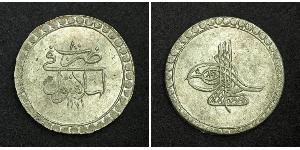1 Yuzluk / 100 Para (Vendida por $46.0)
1804, Ottoman Empire, Selim III. Large Silver Yuzluk (Turkish Dollar) Coin.
Mint Place: Istanbul (Turkey)
Reference: Davenport 334, KM-507.
Denomination: Yuzluk (Turkish Dollar)
Mint Date: 1804 (1203AH/1789AD + Regnal Year 15)
Condition: Lightly porous and uneven planchet (as made, not corroded), otherwise VF-XF!
Material: Silver (.465)
Diameter: 44.2mm
Weight: 31.75gm
Obverse: State seal (Tughra) of Selim III above mint formula and accession date (AH 1203).
Reverse: Four lines of legends within decorative frame. Regnal year (15) at the end of third line.
A great lover of music, Sultan Selim III was a composer and performer of significant talent. He created fourteen makams, melodic types, three of which are in current use today. Sixty-four compositions belonging to Selim III are known, some of which are part of the regular repertory of Turkish classical music performers. Aside from composing music, Selim III also performed on the ney and tanbur.
Selim III (Ottoman Turkish: ???? ???? Selim-i salis) (December 24, 1761 – July 28/29, 1808) was the Sultan of the Ottoman Empire from 1789 to 1807. He was a son of Mustafa III (1757–74) and succeeded his uncle Abdülhamid I (1774–89). He was born in Constantinople. His mother was Valide Sultan Mihr-i shah.
The talents and energy with which Selim III was endowed had endeared him to the people, and great hopes were founded on his accession. He had associated much with foreigners, and was thoroughly persuaded of the necessity of reforming his state. But Austria and Russia gave him no time for anything but defense, and it was not until the peace of Iasi (1792) that a breathing space was allowed him in Europe, while Napoleon's invasion of Egypt and Syria soon called for Turkey's strongest efforts and for the time shattered the old-standing Franco-Ottoman alliance.
Selim III profited by the respite to abolish the military tenure of fiefs; he introduced salutary reforms into the administration, especially in the fiscal department, sought by well-considered plans to extend the spread of education, and engaged foreign officers as instructors, by whom a small corps of new troops called nizam-i-jedid were collected and drilled. So well were these troops organized that they were able to hold their own against rebellious Janissaries in the European provinces, where disaffected governors made no scruple of attempting to make use of them against the reforming sultan.
Emboldened by this success, Selim III issued an order that in future picked men should be taken annually from the Janissaries to serve in their ranks.
The Janissaries and others who opposed reforms rebelled at Adrianople, and due to their number, exceeding 10,000, and the violence of their opposition, it was decided that the reforms must be given up for now. Serbia, Egypt and the principalities were successively the scene of hostilities in which Turkey gained no successes, and in 1807 a British fleet appeared at Istanbul, strangely, to insist on Turkey's yielding to Russia's demands besides dismissing the ambassador of Napoleon (see Dardanelles Operation).
Selim III was, however, thoroughly under the influence of this ambassador, Sebastiani, and the fleet was compelled to retire without effecting its purpose. But the anarchy, manifest or latent, existing throughout the provinces proved too great for Selim III to cope with. The Janissaries rose once more in revolt, induced the Sheikh-ul-Islam to grant a fetva against the reforms, dethroned and imprisoned Selim III, and placed his cousin Mustafa on the throne, as Mustafa IV (1807–08).
The pasha of Rustchuk, Mustafa Bayrakdar, a strong partisan of the reforms, collected an army of 40,000 men and marched on Constantinople with the purpose of reinstating Selim III, but he came too late. The ill-fated reforming Sultan had been stabbed in the seraglio by the Chief Black Eunuch and his men, and Bairakdar's only resource was to wreak his vengeance on Mustafa IV and to place on the throne Mahmud II (1808–39), the sole surviving member of the house of Osman.
Another version of his murder states that after his deposition, Selim was staying at the Harem. The night of Thursday, July 28, 1808, he was with his favourite lady, Refet Kadin, and a slave girl or perhaps another favourite Pakize Kadin in attendance. Alemdar Pasha, a loyalist of Selim, was approaching the city with his army to reinstate Selim. Therefore Mustafa IV gave orders to murder him and his brother Prince Mahmud. The assassins were apparently a group of men, including the Master of the Wardrobe called Fettah the Georgian, the Treasury steward Ebe Selim, and black eunuch named Nezir Aga. Selim apparently knew his end was coming when he saw their swords drawn. Pakize Kadin threw herself between them and her lord, she was cut in her hand. Refet Kadin started screaming in terror, another slave girl who rushed in fainted when she saw what was about to happen. A struggle ensued and the former sultan was cut down and murdered, his last words apparently being "Allahu Akbar" ("God is great"). Refet Kadin threw herself on the body but was dragged away. The body was quickly wrapped in a quilt. The assassins moved on to find Prince Mahmud and attempt to murder him too, he was more fortunate though and had the assassins executed later. Selim III would be the only Ottoman sultan to be killed by the sword. He died in Istanbul.

|
Publicado por:
anonymous 2014-10-06 |
|
||
|
||
|
||
|
||
|
||
1/2 Pound Reino de Inglaterra (927-1649,1660-1707) Oro Isabe ...
grupo tiene 12 monedas / 9 precios
⇑
5 Peso México (1867 - ) Oro
grupo tiene 12 monedas / 11 precios
⇑

-600-300-kaQKbzbiRdQAAAFIVhmkbgOR.jpg)

-300-150-rzEK_j7gmaYAAAFBo_9JIkyt.jpg)
 English
English






-300-150-orHBwcI0ZxYAAAEoC2H7lKu1.jpg)

-300-150-Y24KbzbiOlcAAAFLnfdKKMS9.jpg)






